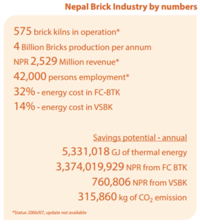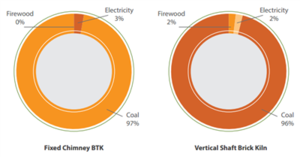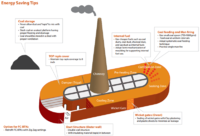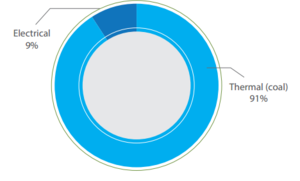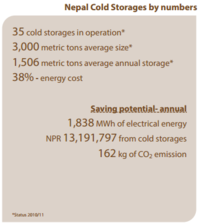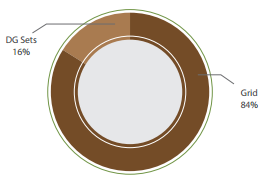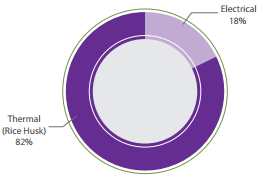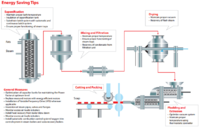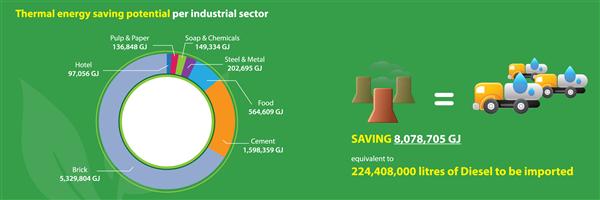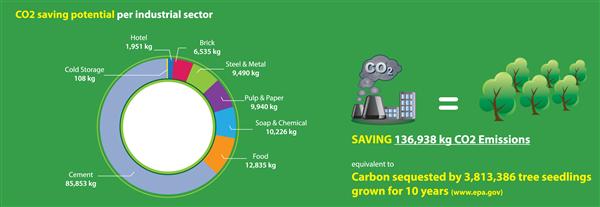Knowledge fuels change - Support energypedia!
For over 10 years, energypedia has been connecting energy experts around the world — helping them share knowledge, learn from each other, and accelerate the global energy transition.
Today, we ask for your support to keep this platform free and accessible to all.
Even a small contribution makes a big difference! If just 10–20% of our 60,000+ monthly visitors donated the equivalent of a cup of coffee — €5 — Energypedia would be fully funded for a whole year.
Is the knowledge you’ve gained through Energypedia this year worth €5 or more?
Your donation keeps the platform running, helps us create new knowledge products, and contributes directly to achieving SDG 7.
Thank you for your support, your donation, big or small, truly matters!
Nepal - Energy Efficiency in Industry
Overview
Although, Nepal has the second largest hydropower resources in the world, it is still suffering from high energy shortage since several years. This power crisis has resulted in scheduled power outages (called load shedding) up to 12 hours per day in the dry season when the run-off-the-river hydropower plant cannot meet the electricity demand.
Particularly, industry is suffering because they have to shut down during load shedding or to run costly fuel based backup systems. The import of petroleum product has increased sharply during the last decade resulting in a trade deficit with India. However, energy is scarce and expensive it is often not used efficiently and wasted. This article gives an overview about energy saving potentials in eight energy-intensive sectors of Nepal.[1]
Industrial Sectors
Brick Sector
Sector highlights
Brick is a primary construction material in Nepal. Around 575 Brick kilns are in operations (Status 2006/2007) having a production capacity from 15,000 to 50,000 brick per day. Most of them operates only during dry season from December to June. Clay is the main raw material used in this industry and is available at very low cost. However, brick making is an energy and labour intensive industrial process. Hand moulding of green brick is mostly used. The predominant kiln technology in Nepal is the Fixed Chimney Bull Trench Kiln (FC-BTK). Apart from BTKs, Clamp Hoffmann and Vertical Shift Brick Kiln (VSBK) can be also found.
Energy use
Coal is the main energy source used in the brick kilns in Nepal and is mostly imported from India. Small amount of sawdust, fire wood and biogas are sometimes also used as fuel. The energy cost on product value is 32% for FC-BTK and 14% for VSBK.
Energy Saving Potential
Thermal energy savings in Nepal’s brick sector is estimated to be 34% for the FC-BTK kiln technology and 4% for VSBK. It is estimated that brick kiln owners could save a total amount of NPR 3.45 Million every year by implementing energy efficiency measures.
Cement Sector
Sector highlights Cement is a commonly used as a basic building material in the country. About 70% of the cement used in the construction sector is manufactured in Nepal. There are two types of cement factories, namely, limestone-based and clinker-based. Limestone-based industry use the raw material limestone, that is abundantly available in Nepal, and burn the clinker and process the clinker to cement. Clinker-based factories import the clinker from India and process it to cement. There are more than 60 cement industries in Nepal; most of them clinker-based. Few new large units have a production capacity between 900 to 1,000 tons per day are in pipeline.
Energy Use
Main source of energy used in Cement factories is electricity and coal. Limestone-based units use coal for calcination. Clinker-based units use mainly electricity for grinding. Limestone-based cement plants is very energy-intensive with about 48% of energy cost on production value. In clinker-based units on 5% of the cost is due to energy.
Energy Saving Potential
Saving potentials are estimated to be around 41% and 49%, respectively for limestone and clinker-based industry. In total Nepalese cement units could annually save about NPR 1.5 Billion by using energy-efficient technologies.
|
| |
Cold Storage Sector
Sector highlights
Cold storage units in Nepal are mainly used to store agriculture products such as potatoes, fruits, etc. Few of them store also meat items. There are about 35 cold storage units running in the country with an average size of 3,000 metric tons. The electricity price for cold storage is subsidized by 50%.
Energy Use
Cold storage units use only electricity that is provided by Nepal Electricity Authority (NEA). During power outage (load shedding) power is supplied through Diesel based backup systems. Electricity is mainly consumed for the cooling process. Energy cost on product value in cold storage sector is estimated to be 38%.
Energy Saving Potential
Energy Saving potentials are around 20% which is equivalent to 1,800 Megawatt hours annually. By going energy-efficient cold storage units could save about NPR 13 Million on energy cost every year.
Hotel Sector
Sector highlights
Tourism including the hospitality is recognized as one of the key sector for economic development in Nepal. According to 2010 data, 789 Hotels are providing more than 30,000 bed for hospitality. Hotel business has grown by nearly 15% as compared to previous years and is one of the highest contributors for foreign exchange reserves.
Energy Use Hotels in Nepal use electricity as well as thermal energy in form of diesel, and LPG. Major energy is consumed for refrigeration, air conditioning, lighting, steam and hot water and cooking. Increased hours of scheduled power outage (called load shedding) has increased the energy costs in hotels due to the fact that they have to run diesel-based backup systems. Small and no-star hotels are unable to provide air conditioning service during power outage resulting in lower occupancy. Main source of energy is still electricity followed by diesel, and LPG.
Energy Saving Potential
About 8% of product value is spend on energy in hotels. Saving potentials are estimated to be 39% whereas 65% for electrical and 16% for thermal energy. In total the hotel sector could save a total amount of NPR 360 Million every year by implementing energy efficiency measures.
|
|
|
|
|
Pulp and Paper Sector
Sector highlights
Almost four decade ago paper industry was established in Nepal. The number of pulp and paper units amount to about 46 providing around 2,000 jobs (CBS, 2007). The average installed capacity is about 45 tons per day whereas the average production is 22 tons per day. Nepal’s paper units are producing two types of product: 1.Bleached writing/printing paper & newsprint paper; 2.Unbleached craft paper. For paper making 63% non-wood pulp and 37% scrapped papers is used as raw material.
Energy Use
In pulp and paper plants electricity is used for lighting. Thermal energy is used for boilers to generate steam. Many units have already switch to rise husk boiler.
Energy Saving Potential
The energy cost is estimated at 20% of product value. Energy saving potential in pulp and paper industry is 2% on electrical and 8% on thermal side. A total amount of NPR 33 Million on energy cost could be saved by this sector through energy efficiency measures.
Soap Sector
Sector highlights
Soap and chemical industry in Nepal produces mainly laundry soap; around 15% of the units manufacture also toilet soap. A total of 31 industries employs around 1,700 peoples with value addition of NPR 1.35 Billion (CBS, 2006/2007). The average soap production amounts to 15 tons per day.
Energy Use
Soap and chemical industries consumers both electrical as well as thermal energy. Mainly rice husk, is used as source of thermal energy for boilers. Electrical energy is used for drives, compressed air generation, refrigeration and lighting.
Energy Saving Potential
The energy cost on product value is 5% for the soap and chemical industries. Energy saving potential for electrical and thermal are estimated to be 10% and 39% respectively. Energy efficiency could lead to annual savings of abound NPR 42 Million.
Steel and Metal Sector
Sector highlights
Steel and metal Industry in Nepal can be differentiated into three different classes namely: 1 basic iron and steel, 2. structural metal products, and 3. forging pressing and stamping of metal. However, this study only covers the first class basic iron and steel in general and re-rolling mills in particular.
Nepal iron and steel industry is one of the top export earnings of Nepal with a growth rate of 1.2% (status 2011). Iron rod, steel rod, stainless steel, cast iron pipe, tin sheet are some of the export items of this industry. A total of 17 steel rolling mill units account for the employment of about 2,400 peoples (CBS, 2006/2007) and contributes with a value addition of NPR 1.9 Billion. The average production is about 113 tons per day.
Energy Use
Main sources of energy used in the Iron and Steel industries in Nepal are furnace oil, electricity and coal. Coal is mainly used in the re-heating furnace for billet heating. Furnace oil or diesel is used in place of coal by some industries. Steel rolling mills also uses electricity from the grid. However, all units have diesel generator backup for power supply during load shedding hours when normal production has to stop.
Energy Saving Potential
Energy cost on product values is about 3% and energy saving potential are estimated to be 6% on electricity and 23% on thermal side. Steel rolling mills could save around NPR 283 Million every year by going energy-efficient.
Dairy Sector
Sector highlights
Dairy is an important and growing food industry in the country. In 2006/2007 a total number of 30 dairy units were registered generating employment for around 2,000 people. The average production of milk and milk products over one year was estimated at 1.45 million tons (Economic survey, 2010/11). Nepalese Dairy Industries are producing standard milk as well as other milk products like yogurt, ice-cream, cheese and butter.
Energy Use
There are three major process steps for milk and milk products, namely chilling of raw milk for intermediate storage, heating of milk (Pasteurization or boiling) and, finally, cooling for storage and distribution. Industries use significant amount of electrical as well as thermal energy for operating the motors and drives as well as for compressors of chilling units. Main source of electricity is the national grid, whereas diesel generators are used during power outage. Thermal energy is required for the operation of boilers that generate steam for the pasteurization of milk and other processes. Rice husk and diesel is used for boiler operation. Small amounts of other fuels such as furnace oil, kerosene and coal are also used.
Energy Saving Potential
The energy cost on product value in dairy industry is estimated to be around 5%. Energy saving potential for the sector is about 6% on electrical side and 14% on thermal side. The sector could saving a total amount of NPR 257 Million annually by implementing energy efficiency measures.
Summary
Through energy efficiency Nepalese industries could save about 160,000 MWh hours electricity every year which is equivalent to the annual consumption fo 215,000 Nepalese households. On thermal energy the saving potential is about 8 Giga Joule which is equivalent to the import of 215 Billion litres of Diesel. Converted into carbon emission a total amount of 136 ton of CO2 could be mitigated which is the same amount of carbon requested by 4 billion tree seedlings grown for 10 years.
Further Information
References
- ↑ NEEP, 2012: Baseline Study of Selected Sector Industries to assess The Potentials for more Efficient use of Energy. Prepared by PACE Nepal for Nepal Energy Efficiency Programme (NEEP) of the Water and Energy Commission Secretariat (WECS), supported by German Development Cooperation GIZ. Retrieved from: http://wecs-neep.gov.np/downloadthis/120220_baseline_report.pdf

